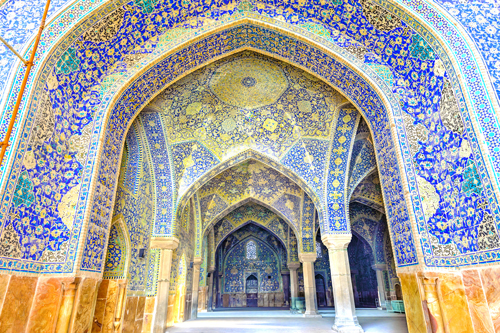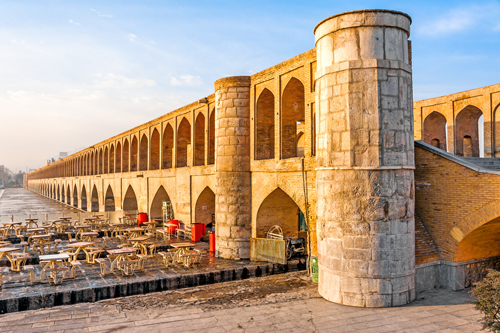Iran
Iran or Persia is a country in Western Asia. Since 1980 country officially became The Islamic Republic of Iran. Iran is bordered on the north by Armenia, Azerbaijan and Turkmenistan, with Kazakhstan and Russia across the Caspian Sea; on the east by Afghanistan and Pakistan; on the south by the Persian Gulf and the Gulf of Oman; on the west by Iraq; and on the northwest by Turkey. Comprising a land area of 1,648,195 km2 (636,372 sq mi), it is the second-largest nation in the Middle East and the 18th-largest in the world. Population of Iran is over 77 million people, it is the world's 17th most populous nation. It is the only country that has both a Caspian Sea and Indian Ocean coastline. Iran is divided into 31 provinces , each governed by an appointed governor. The provinces are divided into counties, and subdivided into districts and sub-districts.
The name of Iran is the Modern Persian derivative from the Proto-Iranian term Aryānā, meaning "Land of the Aryans", first attested in Zoroastrianism's Avesta tradition. Historically Iran has been referred to as "Persia" by the Western world, mainly due to the writings of Greek historians who called Iran Persis , meaning land of the Persians.
Iran is home to one of the world's oldest civilizations, beginning with the formation of the Proto-Elamite and Elamite kingdom in 3200 – 2800 BCE. The Iranian Medes unified the country into the first of many empires in 625 BCE, after which it became the dominant cultural and political power in the region. Iran reached the pinnacle of its power during the Achaemenid Empire (First Persian Empire) founded by Cyrus the Great in 550 BCE, which at its greatest extent comprised major portions of the ancient world, stretching from the Indus Valley in the east, to Thrace and Macedon on the northeastern border of Greece, making it the largest empire the world had yet seen. The empire collapsed in 330 BCE following the conquests of Alexander the Great. The area eventually regained influence under the Parthian Empire and rose to prominence once more after the establishment of the Sasanian dynasty (Neo-Persian empire) in 224 CE, under which Iran became one of the leading powers of Western and Central Asia for the next four centuries.
Manichaeism and Zoroastrianism were largely replaced after Rashidun Muslims invaded Persia in 633 CE, and conquered it by 651 CE. Iran thereafter played a vital role in the subsequent Islamic Golden Age, producing numerous influential scientists, scholars, artists, and thinkers. The emergence in 1501 of the Safavid dynasty, which promoted the Twelver school of thought as the official religion, marked one of the most important turning points in Iranian and Muslim history. It also culminated into tensions, which in 1514 led to the Battle of Chaldiran. The Persian Constitutional Revolution of 1906 established the nation's first parliament, which operated within a constitutional monarchy. Following a coup d'état instigated by the UK and the US in 1953, Iran gradually became autocratic. Growing dissent against foreign influence and political repression culminated in the Iranian Revolution, which led to the establishment of an Islamic republic on 1 April 1979.
Economy of the nation is a mixture of central planning, state ownership of oil and other large enterprises, village agriculture, and small-scale private trading and service ventures. Iran is ranked as an upper-middle income economy by the World Bank.
Tehran
Tehran is the capital and largest city of Iran and Tehran Province, serving as the cultural, commercial, and industrial center of the nation. With a population of around 8.3 million and surpassing 14 million in the wider metropolitan area, Tehran is Iran's largest city and urban area, and the largest city in Western Asia. The city is home to many, historic mosques, churches, synagogues and Zoroastrian fire temples. However, modern structures, notably Azadi (Freedom) Tower and the Milad Tower, have come to symbolize the city. Tehran is ranked 29th in the world by the population of its metropolitan area. Tehran is an important historical city in the area, is known as Rey, which is etymologically connected to the Old Persian and Avestan Ragha. The city was a major area of the Iranian speaking Medes and Achaemenids. Tehran became the capital of Iran in 1778.Throughout Iran's history, the capital has been moved many times, and Tehran is the 32nd national capital of Iran although it has been Iran's capital for about 220 years. Roughly 99% of the population understand and speak Persian even though varity of languages spoken in the region. The majority of people in Tehran identify themselves as Persians. In pre-Islamic and early Islamic times, Tehran was an unimportant village and part of the area of present-day Tehran was occupied by Rey (which in the Avesta occurs in the form of Ragha), now a part of the city of Tehran, which took over its role after the destruction of Rey by the Mongols in the early 13th century.
Isfahan
Another big city of Iran is Isfahan which is the capital of Isfahan Province, located about 340 kilometres (211 miles) south of Tehran. It has a population of 1,583,609 and is Iran's third largest city after Tehran and Mashhad. Isfahan is located on the main north-south and east-west routes crossing Iran, and was once one of the largest cities in the world. It flourished from 1050 to 1722, particularly in the 16th century under the Safavid dynasty, when it became the capital of Persia for the second time in its history. Even today, the city retains much of its past glory. It is famous for its Islamic architecture, with many beautiful boulevards, covered bridges, palaces, mosques, and minarets. This led to the Persian proverb "Esfahān nesf-e jahān ast" (Isfahan is half of the world).[4]
The Naghsh-e Jahan Square in Isfahan is one of the largest city squares in the world and an outstanding example of Iranian and Islamic architecture. It has been designated by UNESCO as a World Heritage Site. The city also has a wide variety of historic monuments and is known for the paintings and history.




